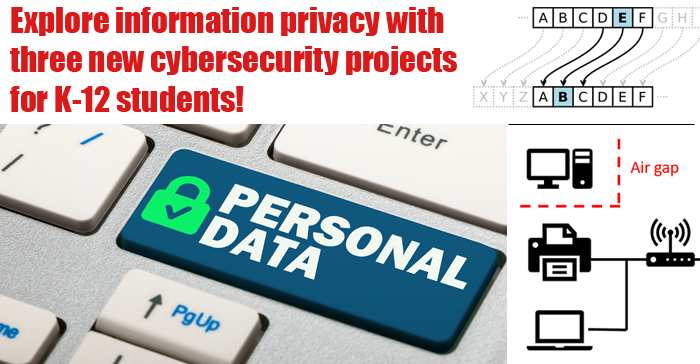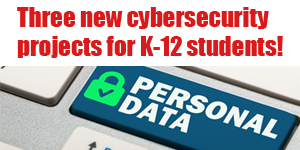New Cybersecurity Projects for Students
Safeguarding personal information in our digital age requires being smart about online safety, privacy, and cybersecurity risks. Thanks to support from Symantec, students can learn more about cybersecurity with three new hands-on science projects developed by Science Buddies' scientists especially for K-12 students. From investigating the availability of personal data online to learning more about encryption and exploring air-gapped computer hacking, these new projects tackle a diverse set of cybersecurity issues that involve social science, physics, and computer programming.

With more and more information being requested, exchanged, and stored online, cybersecurity is an ever-present concern, and it is a topic that students need to learn about as early as elementary school. By the time first accounts are created and passwords set, students need to have an understanding of the importance of keeping this information private and should have strategies for setting smart passwords and safeguarding personal information.
The recent Equifax breach, a cybersecurity failure that resulted in an estimated 143 million U.S. consumers' personal data being exposed, highlights the critical importance of cybersecurity and the risk that every single person faces in this highly digital age. In the case of some threats, like the Equifax breach, there may be very little an individual can do to minimize personal risk. But in other areas of your day-to-day use of the Internet, there are strategies you can use to help lower your risk of being the victim of a cyberattack, password hacking, or identity theft.
Exciting New Cybersecurity Projects
Thanks to support from Symantec Corporation, Science Buddies has developed three new scientist-authored cybersecurity projects for K-12 students. Each of these projects guides students in better understanding an area of online security or cybersecurity risk and the challenge of safeguarding personal or sensitive information. These projects help students develop safer approaches to online interactions, password setting, and data protection as well as guide students in thinking about the real-world problems related to hacking and online security.
The following STEM project ideas are new additions to the Cybersecurity interest area at Science Buddies:
- How Secure Are Your Security Questions?
It used to be that a question like "What is your mother's maiden name?" felt secure. Your mother's maiden name may once have felt like a fairly private and obscure piece of information, something only you or your immediate family might know. Today, however, questions like this are commonly used as "hints" or "security questions" when setting up different kinds of accounts. Instead of being a private detail, this kind of information is something more and more systems know about you. In addition, this kind of information may be something that people can find out about you through various public sites, social media streams, or other publicly accessible online locations. Who was your 3rd grade teacher? How hard is it to find this information out about you?
In this cybersecurity project idea, students develop a list of common security questions and experiment to see if they can locate the answers to these questions about a group of volunteers. Students also survey volunteers to better understand how much people know about Internet security and what kinds of personal information can be easily found online. What students learn may help them think more carefully about which security questions they use and what answers they provide and might encourage their volunteers to change the approaches they use, too!
- Crack the Code: Breaking a Caesar Cipher
Encryption is an important part of protecting information from being read by someone other than the intended recipient. In cybersecurity, encryption strategies help keep data transmitted online private. But encryption doesn't have to be digital. Kids sometimes use secret code to write messages to one another. A Caesar cipher is one way to write encoded messages. By shifting a certain number of places along the alphabet and then substituting a specific letter from the shifted alphabet for each letter in the normal alphabet, people can write secret messages. As long as the recipient knows how many letters were shifted, she can decode and read the message. Cracking this kind of encoding often appears in puzzle magazines, too. Puzzle solvers are presented with encoded text and challenged to decode it. How difficult is it to figure out the key to manually decode a Caesar cipher?
In this advanced computer science project idea, students learn about Caesar ciphers and then use Python to write programs to decode a Caesar cipher by brute force (testing all combinations) and then again using frequency analysis of the letters to more quickly narrow in on the cipher key. Modern encryption strategies are more complicated than a Caesar key, but for students interested in computer coding, this project offers a concrete problem to be explored and tested with scripts that the student writes independently. By exploring how difficult (or not) it is to crack Caesar cipher encryption with a computer program, students get a hands-on look at an important area of cybersecurity as well as practice writing their own code.
- Hacking the Air Gap: Stealing Data from a Computer that isn't Connected to the Internet
It might seem like disconnecting a computer from the Internet would safeguard the computer from hackers and cybersecurity risks. Unfortunately, this is not necessarily the case! Even without an Internet connection, a computer's data can be spied on or stolen using light, sound, vibration, and even heat. A computer that has no Internet connection is referred to as an air-gapped computer. Air-gapped computers may be used by companies when very sensitive information is stored on the computer, but even air-gapped computers may be at risk.
In this cybersecurity project, students learn more about ways data can be captured from an air-gapped computer. Students will choose possible transmission sources (like screen brightness or the vibration from typing on a keyboard) to explore and then test to see how these variables can be monitored, how far away the variable can be detected, and what safeguards may help minimize the risk. In this project, students can use Google's Science Journal app to demonstrate how data can be picked up by a nearby smartphone.
Making STEM Career Connections
The news is full of examples of cybersecurity problems, and individuals must be cautious and constantly on the lookout for phishing scams, fake websites, and other malicious attempts to steal data or spread viruses. Helping companies protect against cybersecurity is an important STEM career path. Students interested in cybersecurity issues may want to learn more about STEM careers like:
White-hat Hackers
White-hat hackers are hackers who detect cybersecurity problems and help companies fix these problems (rather than exploit them). These hackers are commonly referred to as hackers who are hacking for good. Following the announcement of the Equifax breach, a white-hat hacker set up a fake website that ended up being widely linked as "the" site to visit to see if your personal data was impacted by the breach. Luckily, a white-hat hacker controlled the site and not another hacker. That the company inadvertently linked to the fake site (rather than the real one) underscores how easy it is even for large companies to make errors in linking. To learn more about white-hat hackers, see the White-hat Hackers: Cybersecurity Specialists post.
View other related projects in the Cybersecurity special interest area.
See also: Checking Out Cybersecurity: Summer Science at the Library
Symantec is a proud sponsor of Science Buddies and supports the creation of K-12 STEM materials that raise awareness of cybersecurity and related STEM career paths.
Categories:
You Might Also Enjoy These Related Posts:
- Plastics and Earth Day - Science Projects
- Arduino Science Projects and Physical Computing
- 10+ Robotics Projects with the BlueBot Kit
- 5 STEM Activities with Marshmallow Peeps
- March Madness Basketball Science Projects: Sports Science Experiments
- Women in STEM! More than 60 Scientists and Engineers for Women's History Month
- Explore Artificial Intelligence and Machine Learning with Student AI Projects
- 10 Reasons to Do the Rubber Band Car Engineering Challenge










